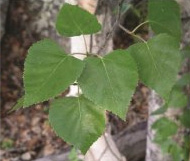Betula papyrifera
 This white barked tree is a wonderful landscape element. Often growing in clumps and pure stands, their distinctive elegance is evident against a snow charged background or an evergreen forest. The striking white bark has horizontal “lenticeis” or breathing pores and is papery and peels in curly strips to expose its orangey inner layers. It has a narrow crown has nearly horizontal branches.
This white barked tree is a wonderful landscape element. Often growing in clumps and pure stands, their distinctive elegance is evident against a snow charged background or an evergreen forest. The striking white bark has horizontal “lenticeis” or breathing pores and is papery and peels in curly strips to expose its orangey inner layers. It has a narrow crown has nearly horizontal branches.
Also called the Paper Birch or the Canoe Birch, many ancient texts were written on its bark and it was used by Native Americans to make the famous birch bark canoes, where they stretched the light bark over heavy cedar frames.
On the First Mother’s Day in 1923 the Paper Birch was planted and called “Mother’s Tree”. It was planted on the South Lawn of the White House in the following year to honor the mother’s of our presidents, then at Arlington to honor mothers of soldiers, and on and on in a linage of trees described as “The Ladies of the Woods”.
 Birch foliage is light, allowing the sun through to the ground so that grass grows all the way up to its base. This also gives it a breezy feel; light and sophisticated. Its leaves are bright green, oval, double-toothed on the edges and pointed on the end. They turn a soft yellow in the fall. The male and female catkins grow on the same tree and produce thousands of tiny seeds that germinate easily, making them great for re-forestation efforts.
Birch foliage is light, allowing the sun through to the ground so that grass grows all the way up to its base. This also gives it a breezy feel; light and sophisticated. Its leaves are bright green, oval, double-toothed on the edges and pointed on the end. They turn a soft yellow in the fall. The male and female catkins grow on the same tree and produce thousands of tiny seeds that germinate easily, making them great for re-forestation efforts.
Birch can grow 50-70 feet tall and attain a 2’ trunk diameter. They can be made into a bonsai or grown in pots if they get plenty of light.
Tea from birch leaves can heal internal sores such as ulcers and cankers and it is high in potassium which helps regulate the body’s PH levels.
Birch are among the hardiest of trees, withstanding extreme cold and wind.
Will grow mid-US to Alaska.
